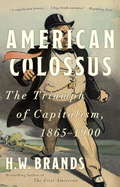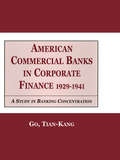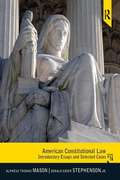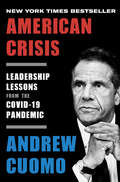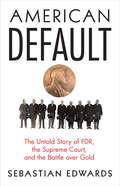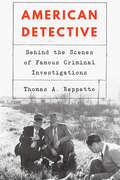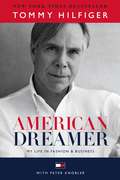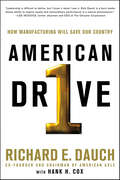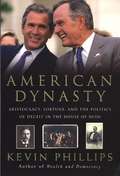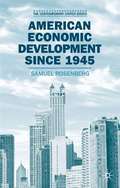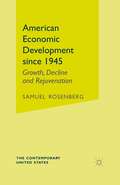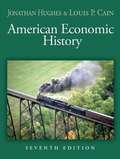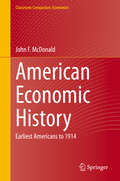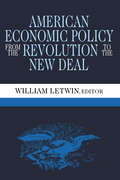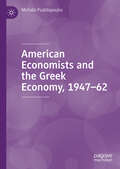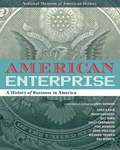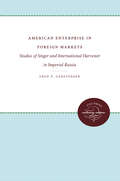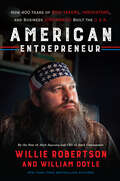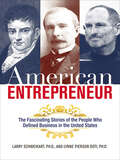- Table View
- List View
American Colossus: The Triumph of Capitalism, 1865-1900
by H. W. BrandsFrom the two-time Pulitzer Prize finalist, bestselling historian, and author of Our First Civil War: a "first-rate" narrative history (The New York Times) that brilliantly portrays the emergence, in a remarkably short time, of a recognizably modern America. American Colossus captures the decades between the Civil War and the turn of the twentieth century, when a few breathtakingly wealthy businessmen transformed the United States from an agrarian economy to a world power. From the first Pennsylvania oil gushers to the rise of Chicago skyscrapers, this spellbinding narrative shows how men like Morgan, Carnegie, and Rockefeller ushered in a new era of unbridled capitalism. In the end America achieved unimaginable wealth, but not without cost to its traditional democratic values.
American Commercial Banks in Corporate Finance, 1929-1941: A Study in Banking Concentrations (Garland Studies In The Financial Sector Of The Economy)
by Go Kang TiaFirst published in 1999. Routledge is an imprint of Taylor & Francis, an informa company.
American Connector Co. (A)
by Gary P. Pisano Sharon RossiAmerican Connector Co. is forced to reexamine operations at its Sunnyvale plant when a Japanese competitor announces plans to build an "ultimate" plant in the United States. Case examines issues related to benchmarking a competitor's manufacturing capabilities and productivity. Allows students to compare two companies' manufacturing strategies and their implications for productivity and flexibility.
American Connector Co. (B)
by Gary P. PisanoPresents a plant manager's proposal to improve operations at American Connector Co. The plan attempts to imitate operations at DJC Corp., a successful Japanese competitor. Requires students to consider how changes in manufacturing impact productivity, flexibility, and overall strategy.
American Constitutional Law: Introductory Essays and Selected Cases
by Grier Stephenson Alpheus Thomas MasonThis classic collection of carefully selected and edited Supreme Court case excerpts and comprehensive background essays explores constitutional law and the role of the Supreme Court in its development and interpretation. Well-grounded in both theory and politics, it endeavors to heighten students' understanding of and interest in these critical areas of our governmental system.
American Crisis: Leadership Lessons from the COVID-19 Pandemic
by Andrew CuomoGovernor Andrew Cuomo tells the riveting story of how he took charge in the fight against COVID-19 as New York became the epicenter of the pandemic, offering hard-won lessons in leadership and his vision for the path forward. When COVID-19 besieged the United States, New York State emerged as the global “ground zero” for a deadly contagion that threatened the lives and livelihoods of millions. Quickly, Governor Andrew Cuomo provided the leadership to address the threat, becoming the standard-bearer of the organized response the country desperately needed. With infection rates spiking and more people dying every day, the systems and functions necessary to combat the pandemic in New York—and America—did not exist. <P><P>So Cuomo undertook the impossible. He unified people to rise to the challenge and was relentless in his pursuit of scientific facts and data. He quelled fear while implementing an extraordinary plan for flattening the curve of infection. He and his team worked day and night to protect the people of New York, despite roadblocks presented by a president incapable of leadership and addicted to transactional politics. Taking readers beyond the candid daily briefings that became must-see TV across the globe, and providing a dramatic, day-by-day account of the catastrophe as it unfolded, American Crisis presents the intimate and inspiring thoughts of a leader at an unprecedented historical moment. <P><P>In his own voice, Andrew Cuomo chronicles the ingenuity and sacrifice required of so many to fight the pandemic, sharing the decision-making that shaped his policy as well as his frank accounting and assessment of his interactions with the federal government, the White House, and other state and local political and health officials. Real leadership, he shows, requires clear communication, compassion for others, and a commitment to truth-telling—no matter how frightening the facts may be. Including a game plan for what we as individuals—and as a nation—need to do to protect ourselves against this disaster and those to come, American Crisis is a remarkable portrait of selfless leadership and a gritty story of difficult choices that points the way to a safer future for all of us. <P><P><b>A New York Times Bestseller</b>
American Default: The Untold Story of FDR, the Supreme Court, and the Battle over Gold
by Sebastian EdwardsThe untold story of how FDR did the unthinkable to save the American economyThe American economy is strong in large part because nobody believes that America would ever default on its debt. Yet in 1933, Franklin D. Roosevelt did just that, when in a bid to pull the country out of depression, he depreciated the U.S. dollar in relation to gold, effectively annulling all debt contracts. American Default is the story of this forgotten chapter in America's history.Sebastian Edwards provides a compelling account of the economic and legal drama that embroiled a nation already reeling from global financial collapse. It began on April 5, 1933, when FDR ordered Americans to sell all their gold holdings to the government. This was followed by the abandonment of the gold standard, the unilateral and retroactive rewriting of contracts, and the devaluation of the dollar. Anyone who held public and private debt suddenly saw its value reduced by nearly half, and debtors--including the U.S. government—suddenly owed their creditors far less. Revaluing the dollar imposed a hefty loss on investors and savers, many of them middle-class American families. The banks fought back, and a bitter battle for gold ensued. In early 1935, the case went to the Supreme Court. Edwards describes FDR's rancorous clashes with conservative Chief Justice Charles Evans Hughes, a confrontation that threatened to finish the New Deal for good—and that led to FDR's attempt to pack the court in 1937.At a time when several major economies never approached the brink of default or devaluing or recalling currencies, American Default is a timely account of a little-known yet drastic experiment with these policies, the inevitable backlash, and the ultimate result.
American Detective: Behind the Scenes of Famous Criminal Investigations
by Thomas A. ReppettoFrom the Roaring Twenties to the 1970s detectives reigned supreme in police departments across the country. In this tightly woven slice of true crime reportage, Thomas A. Reppetto offers a behind-the-scenes look into some of the most notable investigations to occur during the golden age of the detective in American criminal justice. From William Burns, who during his heyday was known as America’s Sherlock Holmes, to Thad Brown, who probed the notorious Black Dahlia murder in Los Angeles, to Elliott Ness, who cleaned up the Cleveland police but failed to capture the “Mad Butcher” who decapitated at least a dozen victims, American Detective offers an indelible portrait of the famous sleuths and investigators who played a major role in cracking some of the most notorious criminal cases in U.S. history. Along the way Reppetto takes us deep inside the detective bureaus that were once the nerve centers behind crime-fighting on the streets of America’s great cities, including the FBI itself, under the direction of America’s “top cop,” J. Edgar Hoover. According to Reppetto, detectives were once able watchdogs until their role in policing became diluted by patrol strategies ranging from “stop and frisk” to community policing. Reppetto argues against these current policing systems and calls for a return to the primacy of the detective in criminal investigations.
American Dream
by William J. Poorvu Richard E. Crum Donald A. BrownExplores the process of purchasing a single family house through the eyes of a young couple. The couple is trying to determine what type of home to buy as well as how to finance it.
American Dreamer: My Life in Fashion & Business
by Quincy Jones Peter Knobler Tommy HilfigerIn this tale of grit and glamour, setbacks and comebacks, business and pop culture icon Tommy Hilfiger shares his extraordinary life story for the first time. Few designers have stayed on top of changing trends the way Tommy Hilfiger has. Fewer still have left such an indelible mark on global culture. Since designing his first collection of "classics with a twist" three decades ago, Tommy Hilfiger has been synonymous with all-American style--but his destiny wasn't always so clear. Growing up one of nine children in a working-class family in Elmira, New York, Tommy suffered from dyslexia, flunked sophomore year of high school, and found himself constantly at odds with his father. Nevertheless, this self-described dreamer had a vision and the relentless will to make it a reality. At eighteen he opened his own clothing store, parlaying his uncanny instinct for style into a budding career as a fashion designer. Through decades of triumph and turmoil, Tommy remained doggedly optimistic. To this day, his approach to commerce is rooted in his positive view of the world.American Dreamer brims with anecdotes that cover Tommy's years as a club kid and scrappy entrepreneur in 1970s New York as well as unique insights into the exclusive A-list personalities with whom he's collaborated and interacted, from Mick Jagger and David Bowie to Ralph Lauren and Calvin Klein. But this is more than just a fashion icon's memoir--it's a road map for building a brand, both professionally and personally. Tommy takes us behind the scenes of every decision--and every mistake--he's ever made, offering advice on leadership, business, team-building, and creativity. This is the story of a true American original, told for the first time in his own words, with honesty, humor, and the insatiable appetite for life and style that proves that sometimes you have to dream big to make it big. Advance praise for American Dreamer "Tommy burst onto the fashion scene at the height of hip-hop and was instantly taken up by rappers and rockers alike. Since then, year after year he has been ahead of the curve with his elegant and stylish looks. His creative energy has always been an inspiration to me. He's really himself in American Dreamer."--Mick Jagger "Whenever I think of Tommy Hilfiger, I think of a designer who has been able to wrap fashion in the American flag. In American Dreamer Tommy shows how he has taken the (rock) stars and the (preppy) stripes and come up with a look--and a label--that are recognized globally as being quintessentially American, as well as a brand that constantly keeps time with pop music."--Anna Wintour "Tommy is an inspiration to many people. American Dreamer shows how he has managed to be successful in business and done so with integrity. I have come to know Tommy, and every time we talk I learn something new about creating a successful business."--David Beckham "Tommy is one of the most genuine people I know! In American Dreamer you can feel his passion pour through everything he does: fashion, fatherhood, family, and friendship!"--Alicia Keys "Tommy Hilfiger is an American icon who was able to transcend fashion and blend it with pop culture and take it to a worldwide audience. American Dreamer documents how, unlike any other designer, Tommy was able to tap into music, its subculture, and its influence on society, which propelled his fashion to be mainstream and global."--Tommy MottolaFrom the Hardcover edition.
American Drive: How Manufacturing Will Save Our Country
by Hank H. Cox Richard E. DauchPoliticians, voters, executives, and employees all want the answer to one question: How can America compete with cheap foreign labor, and restore skilled, well-paying jobs to our economy? American Drive answers that question.An executive with nearly thirty years in the trenches of the hard-nosed Detroit automobile industry, Richard E. "Dick" Dauch had long dreamed of running his own manufacturing company. From his first job on the plant floor at General Motors to his crucial role in helping to rescue Chrysler from the brink of bankruptcy, Dauch focused passionately, and relentlessly, on quality, productivity, and flexibility in manufacturing. In 1993 he took on the challenge of his life, buying a lagging axle supply and parts business from GM, along with five rusting, unprofitable, union-controlled, near-decrepit plants in the heart of a crime-ridden Detroit and a deteriorating environment in Buffalo, New York.The newly created "stand-alone" company was named American Axle and Manufacturing. Dauch set out to create a world-class industrial automotive manufacturer. He bought and bulldozed the crack, liquor, and prostitution businesses that surrounded the company and rebuilt the plants. He upward educated, trained, and expanded the skill sets of the workforce, struck tough bargains with unions, and solved massive quality problems that were costing tens of millions every year and undermining customer satisfaction. Within one year of opening the doors, AAM had turned an astounding $66 million in profit.In American Drive, Dauch narrates the story of AAM against the backdrop of his nearly fifty years in the auto industry, from its glory days to its decline in the face of foreign competition, government bailouts, battles with unions, and the recent Great Recession. Tough, smart, inspiring, high-energy, and opinionated, Dauch offers memorable lessons on leadership, advanced product technology, communication, negotiation, and making profits in the most difficult times. Dauch's story transcends the auto industry and draws a blueprint for job creation, manufacturing competitiveness, economic growth, and excellence in America.
American Dynasty: Aristocracy, Fortune, and the Politics of Deceit in the House of Bush
by Kevin PhillipsThe Bushes are the family nobody really knows, says Kevin Phillips. This popular lack of acquaintance—nurtured by gauzy imagery of Maine summer cottages, gray-haired national grandmothers, July Fourth sparklers, and cowboy boots—has let national politics create a dynasticized presidency that would have horrified America’s founding fathers. They, after all, had led a revolution against a succession of royal Georges. In this devastating book, onetime Republican strategist Phillips reveals how four generations of Bushes have ascended the ladder of national power since World War One, becoming entrenched within the American establishment—Yale, Wall Street, the Senate, the CIA, the vice presidency, and the presidency—through a recurrent flair for old-boy networking, national security involvement, and political deception. By uncovering relationships and connecting facts with new clarity, Phillips comes to a stunning conclusion: The Bush family has systematically used its financial and social empire—its "aristocracy"—to gain the White House, thereby subverting the very core of American democracy. In their ambition, the Bushes ultimately reinvented themselves with brilliant timing, twisting and turning from silver spoon Yankees to born-again evangelical Texans. As America—and the world—holds its breath for the 2004 presidential election, American Dynasty explains how it happened and what it all means.
American Economic Development Since 1945: Growth, Decline And Rejuvenation (Contemporary United States Ser.)
by Samuel RosenbergThis clearly-written book provides an historical analysis of postwar economic development in the United States, helping the reader to understand the nation's current economic position. Samuel Rosenberg investigates three postwar phases: the creation of an institutional framework setting the stage for prosperity in the U. S. after World War II; the forces undermining this institutional framework and the resulting stagflation of the 1970s; and the recreation of a new institutional structure in the 1980s. Basic economic concepts are introduced and explained throughout and specific attention is paid to macroeconomic policy, industrial relations, the role of the U. S. in the world economy, social and labour policy, the structure of the labour force, and the distribution of income by race and gender.
American Economic Development since 1945: Growth, Decline and Rejuvenation (The Contemporary United States)
by S. RosenbergThis clearly-written book provides an historical analysis of postwar economic development in the United States, helping the reader to understand the nation's current economic position. Samuel Rosenberg investigates three postwar phases: the creation of an institutional framework setting the stage for prosperity in the U.S. after World War II; the forces undermining this institutional framework and the resulting stagflation of the 1970s; and the recreation of a new institutional structure in the 1980s. Basic economic concepts are introduced and explained throughout and specific attention is paid to macroeconomic policy, industrial relations, the role of the U.S. in the world economy, social and labour policy, the structure of the labour force, and the distribution of income by race and gender.
American Economic History
by Louis P. Cain Jonathan R. T. HughesIn simple, elegant language, Hughes and Cain walk students through four centuries of political, social, and economic history, with a focus on laws and institutions and an emphasis on current economic topics that reflects the latest scholarship. Rich in both quantitative techniques and economic theory, American Economic History demonstrates how an understanding of our past can illuminate economic issues that face society today and in the future.
American Economic History: Earliest Americans to 1914 (Classroom Companion: Economics)
by John F. McDonaldThis textbook introduces undergraduate and advanced undergraduate students to the economic foundations of America. Providing a rigorous yet accessible exploration of American Economic History from pre-Columbian times up to 1914, it explains the economic and demographic nuances of colonial America, including the Spanish, French, and English colonies and how they were governed. The book presents the details of the controversy between the English colonists and the English Parliament. It further features the impact of slavery, the Revolutionary and Civil War eras, and it includes extensive economic analysis of the post Civil War nation up to 1914. Based on the author's lectures, the book allows an easy understanding of the economic evolution from the earliest Americans to World War I. Instructors can customize their curriculum by supplementing this fundamental text with additional readings, offering flexibility while ensuring a solid knowledge of the economic aspects of American history.
American Economic Policy from the Revolution to the New Deal
by William LetwinThe documents in this volume reflect the great debates that have shaped this country's economic life. Covering a wide variety of problems, they show how each was treated at a moment when it was politically urgent. Since they were efforts at persuasion, usually addressed to a wide audience, they are coherent and self-contained and avoid technical jargon. They therefore present clear and vivid evidence of what men have desired and hoped to achieve, and explain not only much that is critical about how Americans lived in the past but much also about the inheritance of the present.From the overwhelming mass of available documents, a representative group has been chosen here. Among the twenty-nine included are: Hamilton's Report on Manufactures, which helped set the American attitude on economic growth; Andrew Jackson's veto message on the bill to renew the charter of the Bank of the United States; the first annual report of the Interstate Commerce Commission, which put the railroads under federal regulation; William Jennings Bryan's famous Cross of Gold speech, which helped him win the Democratic nomination in 1896; the conclusions of the Pujo Committee's report on the money market, which were instrumental in setting up the Federal Reserve System; and key documents on the National Recovery Administration, one of Franklin D. Roosevelt's major moves in his fight against the depression.In his introductory essay, the editor summarizes the forces and movements that helped to make American economic policy "exceedingly confused and therefore very annoying to historians and economists," But, he insists, this very confusion reduced "the extremism and disorder potentially so great in the United States . . . to remarkable moderation."
American Economists and the Greek Economy, 1947-62
by Michalis PsalidopoulosThis book explores the role of American economists in Greece between 1947 and 1962. With a focus on economic thought and political relations, it examines the Greek economy following the Second World War and highlights the economic ideas and policies that brought Greece out of an economic depression. Collaboration between Greek, American, and British policymakers, economists, politicians, and administrators in providing humanitarian relief, economic rehabilitation and monetary order is highlighted. By examining the specific economic policies and how they were articulated, a nuanced view of policy making is presented that provides insight into policies that were shaped by both New Deal idealism and post-war realism. This book offers unique insights into the post-war reconstruction of Greece and the exchange of ideas between American and Greek economists. It will be of interest to students and researchers working within economic policy issues, international political economy and the history of economic thought.
American Electric Power: Facing the Challenges of Distributed Generation
by Richard H.K. Vietor Hilary WhiteAmerican Electric Power, like most utilities in the USA, is currently exposed to distributed generation and the problem of net-metering. Solar installations in particular have been heavily subsidized, by the state and by regulation, which does not allow grid operators to to recover their fixed costs. This results in stranded assets and cross-subsidies from poor to rich.
American Electric Power: Facing the Challenges of Distributed Generation
by Richard H.K. Vietor Hilary WhiteAmerican Electric Power, like most utilities in the USA, is currently exposed to distributed generation and the problem of net-metering. Solar installations in particular have been heavily subsidized, by the state and by regulation, which does not allow grid operators to to recover their fixed costs. This results in stranded assets and cross-subsidies from poor to rich.
American Empire: The Rise of a Global Power, the Democratic Revolution at Home 1945-2000
by Joshua B. FreemanIn this landmark work, acclaimed historian Freeman has created an epic portrait of the movements and developments that propelled America to world dominance both galvanized by change and driven by conflict.
American Enterprise
by Nancy Davis Andy Serwer David Allison Peter Liebhold Kathleen G. FranzWhat does it mean to be an American? What are American ideas and values? American Enterprise, the companion book to a major exhibition at the Smithsonian's National Museum of American History, aims to answer these questions about the American experience through an exploration of its economic and commercial history. It argues that by looking at the intersection of capitalism and democracy, we can see where we as a nation have come from and where we might be going in the future.Richly illustrated with images of objects from the museum's collections, American Enterprise includes a 1794 dollar coin, Alexander Graham Bell's 1876 telephone, a brass cash register from Marshall Fields, Sam Walton's cap, and many other goods and services that have shaped American culture. Historical and contemporary advertisements are also featured, emphasizing the evolution of the relationship between producers and consumers over time. Interspersed in the historical narrative are essays from today's industry leaders--including Sheila Bair, Adam Davidson, Bill Ford, Sally Greenberg, Fisk Johnson, Hank Paulson, Richard Trumka, and Pat Woertz--that pose provocative questions about the state of contemporary American business and society. American Enterprise is a multi-faceted survey of the nation's business heritage and corresponding social effects that is fundamental to an understanding of the lives of the American people, the history of the United States, and the nation's role in global affairs.
American Enterprise in Foreign Markets: Studies of Singer and International Harvester in Imperial Russia
by Fred V. CarstensenIn 1914 the two largest firms in Russia were subsidiaries of American companies. Remarkably, they were almost as large as their parent companies, striking testimony to the potential of the underdeveloped Russian market. Fred Carstensen provides detailed histories of the movement of International Harvester and Singer into this new, profitable, and somewhat forbidding territory.Describing how both sales organizations evolved in Russia, Carstensen relates their development to overall company histories, worldwide growth, changing sales strategies and structures, recruitment and training of employees, and corporate leadership in America and abroad. He finds that both firms entered the Russian market because they needed new outlets to sustain high levels of production and sales. Although there are parallels in their experiences, Carstensen identifies how the responses of the two corporations differed, reflecting the varying strategies and perceptions of company management.Together the case studies provide a test for many of the supposed qualities and patterns of Russian economic history. Contrary to accounts of the experiences of other companies, these firms found the Russian market remarkably rich, developing a level of sales that might have surpassed the American market if war had not erupted. In contrast to the standard view of foreign enterprise, neither company came to Russia because of government invitation or influence but rather because of the intrinsic attractiveness of the markets, and neither firm found the government bureaucracy graft-ridden or the customers dishonest.Carstensen shows that International Harvester and Singer Sewing Machine clearly influenced Russia in a positive way. Both trained large numbers of Russians in modern industrial and marketing procedures and both provided an extraordinary volume of credit on comparatively easy terms to encourage purchase of their products. Indeed, the success of their approach suggests that Russian economic development may have been limited not by weak aggregate demand but by the relative absence of sources of credit.Originally published in 1984.A UNC Press Enduring Edition -- UNC Press Enduring Editions use the latest in digital technology to make available again books from our distinguished backlist that were previously out of print. These editions are published unaltered from the original, and are presented in affordable paperback formats, bringing readers both historical and cultural value.
American Entrepreneur: How 400 Years of Risk-Takers, Innovators, and Business Visionaries Built the U.S.A.
by William Doyle Willie RobertsonAmerica is the ultimate start-up venture – and these are the heroes who made it happenThe history of the United States is, to a remarkable degree, the story of its entrepreneurs, those daring movers and shakers who dreamed big and risked everything to build better lives for themselves and their fellow Americans. Drawing on his own family's remarkable journey, Duck Commander CEO and star of the blockbuster Duck Dynasty series Willie Robertson tells the captivating true tale of the visionaries and doers who have embodied the American dream.We begin with the first American entrepreneurs, the Native Americans, who established a highly sophisticated commercial network across the land in the precolonial days. The original Founding Father, George Washington, was also a founding entrepreneur, at the head of a thriving agribusiness venture that gave him the executive skills to steer the nation through the darkest hours of the American Revolution. Then, of course, there were the mega entrepreneurs, legendary figures like Astor, Vanderbilt, Carnegie, and Rockefeller, who transformed America, connected the country with miles of railroad track and supplied the fuel and steel that would help make America the most powerful nation on earth. And in recent years, business visionaries like Jobs, Gates, and Zuckerberg—not to mention the thousands of equally vital, yet smaller-scale, operators who spring up every year—have ushered America into the twenty-first century.American Entrepreneur also relates the story of the Robertson family business, telling how Willie’s family turned a humble regional duck call manufacturer, founded by his father, Phil, into an international powerhouse brand. From a young age, Willie had the entrepreneurial bug, buying candy in bulk and hawking it on the school bus. He did special orders and earned a small fortune for a ten-year-old—until he was hauled into the principal’s office and told to knock it off. So he transferred his focus to Phil’s fledgling business, helping in whatever way he could, from folding endless numbers of cardboard boxes to acting as the company’s customer service department—though he still wasn’t out of grade school. Willie helped build Duck Commander, which he now runs, into a worldwide brand, culminating in the mega success of the Duck Dynasty television show.American Entrepreneur tells a most American tale, of those among us who, through their vision, ingenuity, and good old-fashioned hard work, made something that changed the world.
American Entrepreneur: The Fascinating Stories of the People Who Defined Business in the United States
by Larry Schweikart Lynne Pierson DotiThis book vividly illustrates the history of business in the United States from the point of view of the enterprising men and women who made it happen.Ever since the first colonists landed in the New World, Americans have forged ahead in their quest to make good on promises of capitalism and independence. Weaving stirring narrative with economic analysis, this historical deep dive recounts the successes and failures of some of the most iconic business people to grace our history books--from the founding of our country to the present day.In American Entrepreneur, you&’ll learn about how:Eli Whitney changed the shape of the American business landscape;the Civil War impacted the economy, and how it was renewed by the subsequent dominance of Andrew Carnegie and J. P. Morgan;Asa Candler, W. K. Kellogg, Henry Ford, and J.C. Penney led the rise of the consumer marketplace;and Warren Buffett&’s, Michael Milken&’s, and Martha Stewart&’s experience in the &“New Economy&” in the 1990s--and how that economy continues today.It is an adventure to start a business, and the greatest risk takers in that adventure are entrepreneurs. This is the epic story of America&’s entrepreneurs and how they created the economy we enjoy today.
